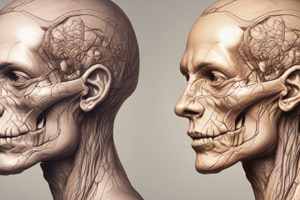Podcast
Questions and Answers
Which muscle protracts the mandible?
Which muscle protracts the mandible?
- Temporalis muscle
- Medial pterygoid muscle
- Lateral pterygoid muscle (correct)
- Masseter muscle
What is the nerve supply for the masseter muscle?
What is the nerve supply for the masseter muscle?
Masseteric branch from anterior division of mandibular nerve.
Match the movement of mandible with the corresponding muscle:
Match the movement of mandible with the corresponding muscle:
Depression = Lateral pterygoid muscle, Mylohyoid, Anterior belly of digastric muscle, Genohyoid, Platysma Elevation = Masseter muscle, Temporalis muscle, Medial pterygoid muscle Protrusion = Lateral pterygoid muscle Retraction = Posterior fibers of temporalis Side to side = Lateral pterygoid muscle, Medial pterygoid muscle
The temporalis muscle originates from the temporal fossa below the ______ temporal line.
The temporalis muscle originates from the temporal fossa below the ______ temporal line.
What are the 5 layers of the scalp abbreviated as? Provide the full form.
What are the 5 layers of the scalp abbreviated as? Provide the full form.
Which muscle of the scalp has two bellies, Occipitalis and Frontalis?
Which muscle of the scalp has two bellies, Occipitalis and Frontalis?
The scalp is supplied by 10 arteries in total.
The scalp is supplied by 10 arteries in total.
The scalp is supplied by 10 __ on each side, 5 in front and 5 behind the auricle.
The scalp is supplied by 10 __ on each side, 5 in front and 5 behind the auricle.
Match the following nerves with their corresponding regions of the scalp: (1) Supratrochlear nerve, (2) Great auricular nerve, (3) Zygomaticotemporal nerve
Match the following nerves with their corresponding regions of the scalp: (1) Supratrochlear nerve, (2) Great auricular nerve, (3) Zygomaticotemporal nerve
Flashcards are hidden until you start studying
Study Notes
The Scalp
- Layers of the scalp: 5 layers (S C A L P)
- Skin: most hairy, thickest, and contains many sebaceous glands
- Superficial fascia: more fibrous and dense, contains blood vessels and nerves of the skin
- Aponeurosis (Occipito-frontalis muscle): has two bellies (occipitalis and frontalis)
- Loose areolar connective tissue: connected to the inside of the skull (cavernous sinus) by emissary veins
- Pericranium: firmly adherent to skull bones
Blood Supply of the Scalp
- Arterial Supply: 10 arteries (5 on each side)
- In front of the auricle: supratrochlear, supraorbital, and superficial temporal arteries
- Behind the auricle: posterior auricular and occipital arteries
- Venous Drainage: veins follow arteries and have the same names
Nerve Supply of the Scalp
- 10 nerves on each side (5 in front of the auricle and 5 behind the auricle)
- Sensory nerves: from trigeminal nerve (supratrochlear, supraorbital, zygomaticotemporal, and occipital nerves)
- Motor nerves: from facial nerve (temporal branch)
The Face
- Skin of the face:
- Very vascular and rich in sebaceous and sweat glands
- Facial skin is oily due to sebaceous glands
- Superficial fascia: contains facial muscles, vessels, and nerves of the skin, and fat
- Deep fascia: absent from the face except over the parotid gland (parotid fascia)
- Facial muscles (Muscles of facial expression):
- Originate from bone and insert into skin
- Bring about different facial expressions
- Examples: orbicularis oculi, procerus, orbicularis oris, and buccinator
Nerve Supply of the Face
- Motor nerve supply: all muscles of the face and scalp are supplied by the facial nerve
- Extra cranial part of the facial nerve
- Leaves the skull through the stylomastoid foramen
- Divides into 5 terminal branches within the parotid gland
- Extra cranial part of the facial nerve
- Sensory nerve supply: trigeminal nerve is the chief sensory nerve of the face
- Gives 3 sensory branches: ophthalmic, maxillary, and mandibular nerves
Venous Drainage of the Face
- Similar to that of the scalp
- Deep connections of the facial vein:
- Communicates with the cavernous sinus through connections with the superior ophthalmic and pterygoid plexus veins
Arteries of the Face
- 3 main arteries: facial, transverse facial, and arteries accompanying cutaneous nerves
- Facial artery: branches of the external carotid artery
- Transverse facial artery: branch of the superficial temporal artery
- Arteries accompanying cutaneous nerves: infraorbital, mental, buccal, supraorbital, and supratrochlear arteries
Parotid Gland
- Site and type: lies in the space between the external acoustic meatus, sternomastoid muscle, masseter muscle, angle of the mandible, and pharyngeal wall
- Parts of the gland:
- Main part
- Deep part (medial narrow edge)
- Post-glenoid part (behind the temporomandibular joint)
- Accessory part (above the parotid duct)
- Parotid duct
- Relations:
- Apex: overlaps posterior belly of the digastric, cervical branch of the facial nerve, and the two divisions of the retromandibular vein
- Superior surface: cartilaginous part of the external acoustic meatus, posterior surface of the temporomandibular joint, and superficial temporal vessels
- Superficial surface: skin, superficial fascia, great auricular nerve, and platysma
- Anteromedial surface: masseter muscle, temporomandibular joint, and posterior border of the ramus of the mandible
- Posteromedial surface: mastoid process, sternomastoid, posterior belly of the digastric, and carotid sheath
Structures within the Parotid Gland
- Facial nerve
- Posterior facial (retromandibular) vein
- External carotid artery
- Deep parotid lymph nodes
- Auriculotemporal nerve
Infratemporal Fossa
- Site: deep to the ramus of the mandible
- Shape and boundaries: has a roof, anterior, posterior, lateral, and medial walls
- Communications:
- With the temporal fossa: passage deep to the zygomatic arch
- With the pterygopalatine fossa: through the pterygomaxillary fissure
- With the middle cranial fossa: through the foramina ovale and spinosum
- With the orbit: through the inferior orbital fissure
- Contents:
- Muscles: lateral and medial pterygoid muscles
- Nerves: mandibular division of the trigeminal nerve, chorda tympani branch of the facial nerve, and otic parasympathetic ganglion
- Vessels: maxillary artery and the pterygoid venous plexus
Studying That Suits You
Use AI to generate personalized quizzes and flashcards to suit your learning preferences.



